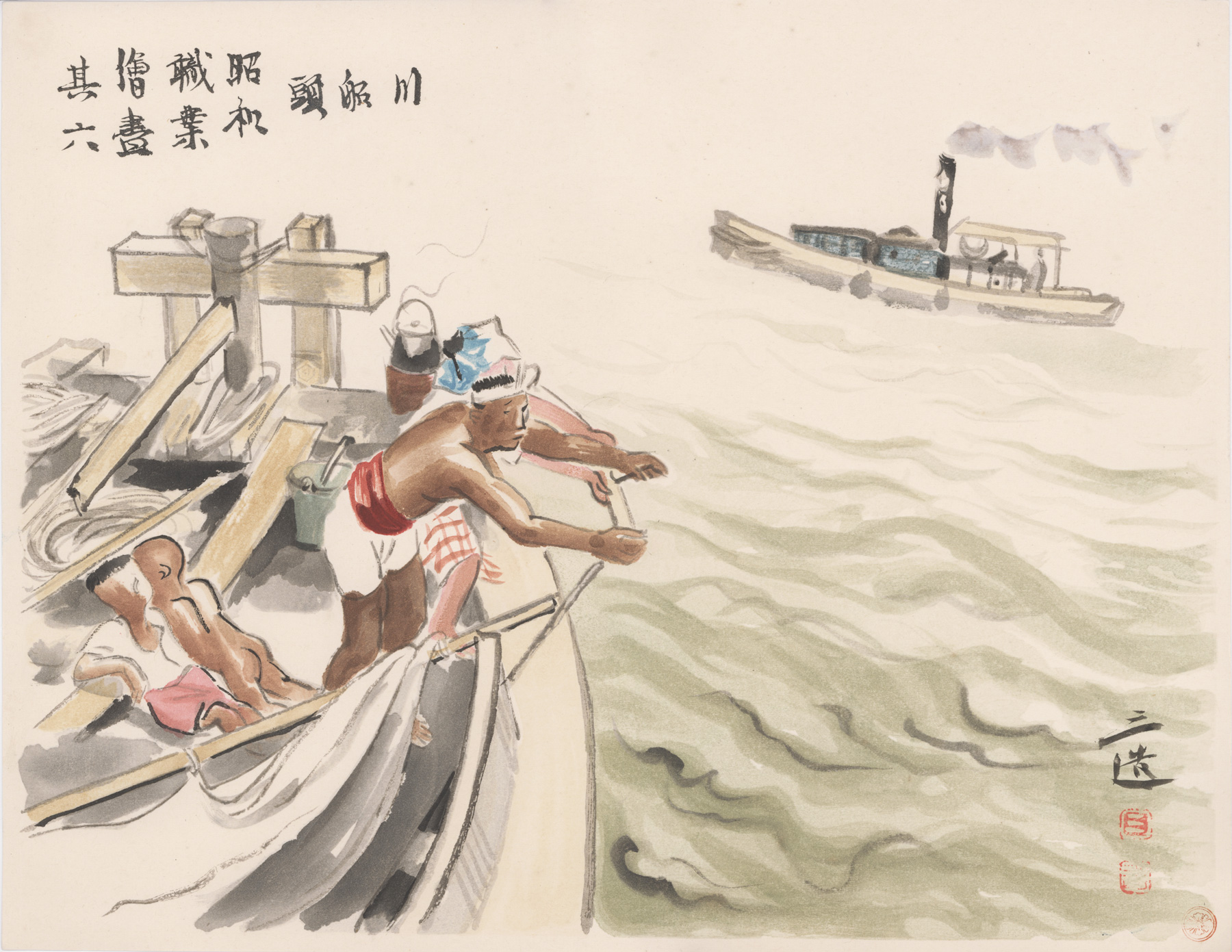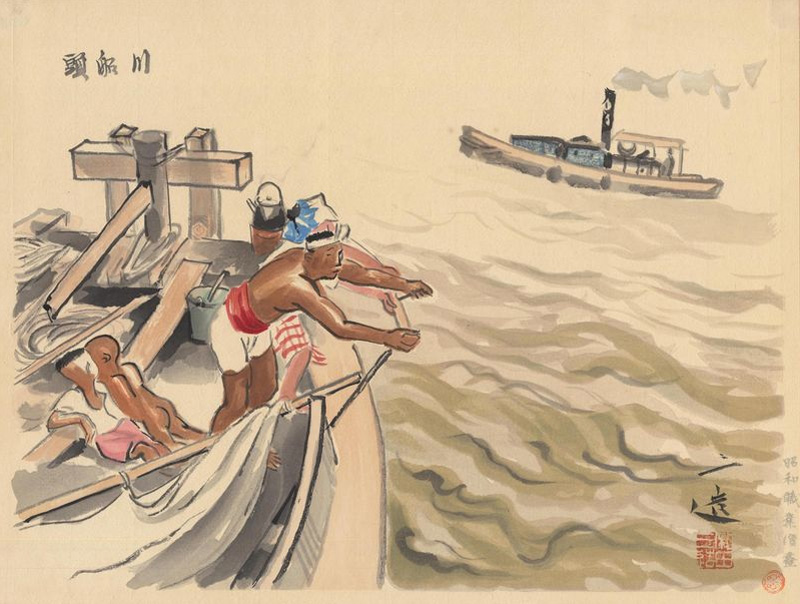About This PrintA helmsman and his wife ply their boat through a fast moving river, while their two children lounge on a plank in the boat. A more modern boat chugs along in the background. This first edition of the print uses a lovely embossing to enhance the movement of the river and the smoke from the boat in the background. Along with the print title, this collection's print has the series title and the number of the print in the series printed within the image area. The vast majority of prints in the series carry the series title in the lower right margin, not within the image area, and not all prints show the series number on the print.
This print was originally issued in 1939 by the publisher Nishinomiya Shoin and bears his seal in the lower right corner. Due to the popularity of this series, Nishinomiya reprinted this image a number of times. Another state of this print without the series title or print number in the upper left is shown below.
It appears that this print was not reissued (a second edition) by Kyoto Hangain who republished many, but not all, of the prints in the series after the war.
As first released by the publisher Nishinomiya Shoin, the below commentary written by the artist and translated into English by "Glenn W. Shaw (1881-1961), a writer and teacher who moved to Japan in 1913."1 (which did not accompany this collection's print), stated:
This is a scene still to be found on the Sumida River. Among the busy steam and motor boats, weaving up and down the stream, slowly move the man-propelled barges.
The occupation of the river boatman, sharing his work with his wife, living day in and day out on the water, making one corner of his narrow boat his world and enjoying his family life there, is a rich possession, alleviating the bewilderment of dizzy modern life.12
|
1 Memories of Shōwa: Impressions of Working Life by Wada Sanzō, Maureen de Vries and Daphne van der Molen, Nihon no hanga, 2021, p. 14. 2 ibid. p. 21
A Critical View of the Series, "Occupations of Shōwa Japan in Pictures" Source: Light in Darkness: Women in Japanese Prints of Early Shōwa (1926-1945), Kendall H. Brown, et. al., Fisher Gallery, University of Southern California, 1996, p. 12. In the introduction to the catalog of the exhibition Light in Darkness: Women in Japanese Prints of Early Shōwa (1926-1945), Dr. Kendall H. Brown, comments: The majority of these wartime prints show male occupations but give little sense of Japan’s military involvements or even Japan’s status as a highly industrialized country. (These characteristics may account for the popularity of the series when reissued after the war.) Only a few prints show military men, and, not surprisingly, they display soldiers in non-military activities such as relaxing in their bunks or studying.
|
Other Print States by Nishinomiya Shoin
Another state of the first edition image source: Ohmi Gallery
About the Series "Occupations of Shōwa Japan in Pictures"
Sources: website of Ross Walker Ohmi Gallery http://www.ohmigallery.com/DB/Artists/Sales/Wada_Sanzo.asp and website of USC Pacific Asian Museum "Exhibition - The Occupations of Shōwa Japan in Pictures: The Woodblock Prints of Wada Sanzō"
Note:
My special thanks to Shinagawa Daiwa, the current owner of Kyoto Hangain, for providing the below information (in a series of emails in July 2014) about Nishinomiya Shoin and Kyoto Hangain, both businesses started by his father Shinagawa Kyoomi. Shinagawa's current website can be accessed at http://www.amy.hi-ho.ne.jp/kyotohangain/ Wada’s major contribution as a woodblock print artist came through his 72 print 3-part series Occupations of Shōwa Japan in Pictures (Shōwa shokugyō e-zukishi), also translated as Occupations of the Shōwa Era in Pictures and Japanese Vocations in Pictures. The three part series was started during the Pacific War (1937-1945) in September 1938, was then interrupted by war shortages in 1943, and was restarted again after the war in January 1954. This series was a labor of love for Wada and he brought together woodblock print printers and carvers in Nishimomiya near Kobe to work on this project.
The war era prints were published by Wada through an old books store, Nishinomiya shoin 西宮書院 run by Shinagawa Kyoomi planned a total of 100 designs, with two prints being issued each month. Wada's designs for the prints were rendered in watercolor and the finished prints beautifully captured the look-and-feel of those original watercolors. The series was an immediate hit, but was suspended after 48 prints (issued in two series) in 1943 due to war shortages. After the war, the series was continued by the same publisher, Shinagawa Kyoomi, who had opened a new business in Kyoto, which he named Kyoto Hangain 京都版画院. (Shingawa's business in Nishinomiya had burned down during WWII.) At first Kyoto Hangain published re-prints of the earlier prints, but they went on to publish a third series of 24 prints, working closely with Wada, titled Continuing Occupations of Shōwa Japan in Pictures between November 1954 and September 1956.1 The post-war prints were popular with the Occupation's "deep-pocketed" military and civilian personnel and the series was "featured in an article of the Tokyo edition of the United States military newspaper Stars and Stripes."2 Shinagawa also published a six print portfolio in the 1950s titled Japanese Life and Customs, consisting of six of the prints from the earlier two series in a reduced chuban size, which is also part of this collection. Occupations of Shōwa Japan in Pictures has been praised for showing “the complexity of Shōwa society…. capture[ing] the pulse of Japanese life during the tumultuous decades of the 1930s, 1940s and 1950s”3 and condemned as providing a “visual message of subtle or blatant propaganda in support of government-sponsored ideas.”4 It is interesting to see how the commentary, written by the artist, that accompanied each print in the pre-war releases was softened for the post-war re-issues by Kyoto Hangain. All references to soldiers being away from home (as Japanese armies were marching through Asia when the series was originally released) or references to Imperial Japan have been stripped away and the commentary becomes innocent, folk-like and appealing to the post-war occupying forces. (For example, see the prints Women Weavers and Picture Card Show which provide the artist's original commentary and a full transcript of the English text attached to the folders of the post-war re-issued prints.)
1 Keizaburo Yamaguchi gives the publication dates of the post-War series as January 1954 through autumn 1958. (Ukiyo-e Art 16, 1967): 39-42. 2 "Out of the Dark Valley: Japanese Woodblock Prints and War, 1937-1945," Kendall H. Brown,p. 82 appearing in Impressions, The Journal of the Ukiyo-e Society of America, Inc., Number 23, 2001.3 Pacific Asia Museum website http://www.pacificasiamuseum.org/_on_view/exhibitions/2004/occshowa.aspx 4 Light in Darkness: Women in Japanese Prints of Early Shōwa (1926-1945), Kendall H. Brown, et. al., Fisher Gallery, University of Southern California, 1996, p. 18.
Print Details | IHL Catalog | #1654 | | Title/Description | 川船頭 其六 - River Boatman [number six]
Note: English name for this print is often seen as "Riverboat Captain" | | Series | Occupations of Shōwa Japan in Pictures, series 1 (also seen translated as "Compendium of Occupations in the Shōwa Era" and "Japanese Vocations in Pictures")
Shōwa shokugyō e-zukushi 昭和職業繪盡 (also seen written as 昭和職業絵尽し and
昭和職業繪盡し), daiishū (第一輯) | Artist
| Wada Sanzō (1883-1967)
| Signature
| 三造 Sanzō | | Seal | "San" and "zō" - seals of artist | | Publication Date | 1939
| | Publisher | seal of Nishinomiya Shoin 西宮 書院 | | Edition | first edition
| | Impression | excellent | | Colors | excellent | | Condition | excellent - print is tipped into original paper display mat
| | Genre | shin hanga
| | Miscellaneous | | | Format | oban
| | H x W Paper | 11 7/16 x 14 15/16 in. (29.1 x 37.9 cm)
| | H x W Image | 10 5/8 x 14 9/16 in. (27 x 37 cm) | | Collections This Print | Himeji City Museum Ⅲ-183-6 (dated "1939~1940年") | | Reference Literature | Memories of Shōwa: Impressions of Working Life by Wada Sanzō, Maureen de Vries and Daphne van der Molen, Nihon no hanga, 2021 |
last revision:8/9/2021 12/5/2018 |






